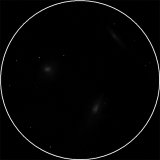
| MESSIER 84 |
|---|
RA: |
12h 25m 06s |
|
DEC: |
+12° 53' 00'' |
|
Type: |
Lenticular galaxy |
|
NGC: |
4374 |
|
Magnitude: |
9.10 |
|
Surface brightness : |
13.00 |
|
Apparent dimensions : |
3.7'x3.0' |
|
Distance: |
60,000,000 ly |
|
M84 has been discovered and cataloged by Charles Messier on March 18, 1781 when he also cataloged 7 more nebulous objects in the same celestial region, all of them member galaxies of the Virgo Cluster, as well as globular cluster M92. M84 is situated in the heavily populated inner core of the Virgo Cluster of galaxies. It is begining of famous Markarians Chain, row of dozen galaxies. From its appearance, it was longly classified as an E1 elliptical, which is also in accordance that it is only populated by old yellowish stars (NED still has this classification). However, there is now some evidence that this may actually be a face-on lenticular galaxy. M84 has a nice system of globular clusters, which is however much less crowded than the system of its giant neighbort, M87, which may mark the center of the Virgo cluster. As a peculiar (but perhaps no way unique) feature, M84 contains a central machine which ejects two small but conspicuous jets, which can be seen in the radio light. A supernova (1957B) was discovered by G. Romano in Italy on May 18,1957 at mag 13. It had also been present on pre-discovery photographic plates taken at Mt. Palomar a month earlier. Supernova 1980I was discovered on June 13, 1980 by Rosker and reached magnitude 14.0. Supernova 1991bg appeared in M84 on Dec 3, 1991 and reached mag 14. Visually, M84 looks like generic elliptical galaxy. It has bright core and halo around it that slowly fades to the edges. |
||
VEDRAN VRHOVAC© 2006.-2007. |
